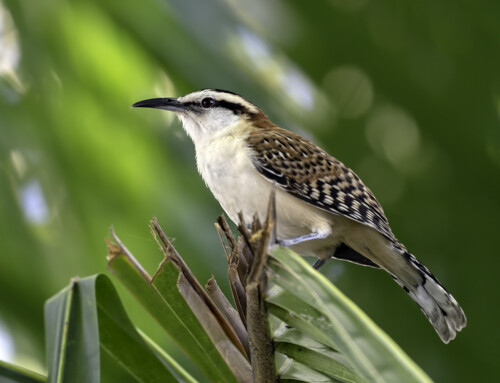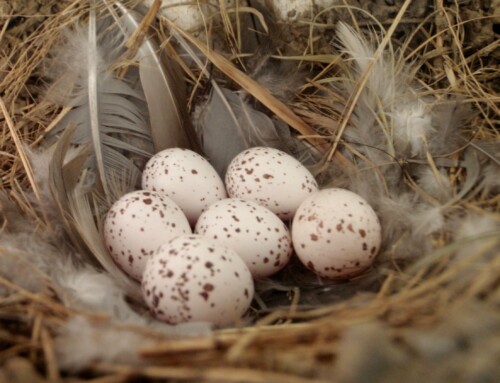What do nymphs, pan pipes and bird song have in common?
LINKED PAPER
Dissecting the roles of body size and beak morphology in song evolution in the “blue” cardinalids (Passeriformes: Cardinalidae). García, N. C., & Tubaro, P. L. 2018. The Auk. DOI: 10.1642/AUK-17-146.1. VIEW
Humans are a very vocal species. Every day we talk, we whisper or shout, we sing. And we are equally used to hear birds singing, even in the most crowded cities. Birds produce vocal sounds with the syrinx, a specialized organ located where the trachea bifurcates into the bronchi. The syrinx consists of a set of membranes that vibrate when air flows and produce sounds. Syrinx was also a nymph, follower of Artemis, a goddess known for her chastity. To avoid the advances of the god Pan, she ran to a river’s edge where the river nymphs transformed her into hollow water reeds. Pan sighed in frustration and the reeds made a haunting sound. The god then cut the reeds to build a musical instrument, the syrinx or pan pipes.
As pipes of different lengths produce different sounds, the properties of both the syrinx and the supra-syringeal tract (trachea, larynx and beak) play a key role in shaping the vocal signals of birds. Species of the Cardinalidae family (cardinals, buntings, grosbeaks) are well known for the complexity and beauty of their songs. We studied song variation among the ‘Blue’ cardinals, a group of closely related species of buntings and grosbeaks (of the Amaurospiza, Cyanocompsa, Cyanoloxia and Passerina genera) that can be found from Southern Canada to Northern Argentina. We wanted to know if vocal diversity among these species (Fig. 1) could be related to differences in body size and beak morphology.
 Figure 1 Systematic relationships among the ‘blue’ cardinals. based on the species tree reconstructed by Bryson et al. (2014) using a multilocus dataset, showing a representative song for each species. Spectrograms are based on recordings from the Cornell University Macaulay Library (CUML). Modified from Garcia and Tubaro 2018. Click to view larger
Figure 1 Systematic relationships among the ‘blue’ cardinals. based on the species tree reconstructed by Bryson et al. (2014) using a multilocus dataset, showing a representative song for each species. Spectrograms are based on recordings from the Cornell University Macaulay Library (CUML). Modified from Garcia and Tubaro 2018. Click to view larger
We found that larger species produced songs with lower frequencies. We think this is because larger birds have larger vocal organs. The membranes of a larger syrinx are expected to vibrate more slowly, producing sounds of lower frequency, which means lower pitched sounds. In a previous study, focused on three species of the group, we had also found that larger species produce the notes of a song at a slower pace (Garcia et al. 2014). Similar results were found in tanagers, another group of songbirds found across the Americas (Mason and Burns 2015). However, it was not clear what could explain this correlation between body size and the temporal structure of song.
As larger species have larger vocal organs, they also usually have larger beaks. On the one hand, if the beak is larger the entire vocal tract is longer, and longer vocal tracts emphasize lower frequencies. On the other hand, larger beaks are assumed to be associated to stronger jaw musculature that allows stronger bite forces, which in turn would prevent fast changes in beak gap to emphasize the corresponding frequency (more open to shorten the vocal tract and emphasize high frequencies and vice versa). Thus birds with larger beaks are predicted to produce notes at a slower rate. In this study, in addition to including more species, we also considered beak size, measuring it depth, length and width and effectively found that species with longer beaks produced notes in the song more separately.
A similar relationship between beak size and note rate had been previously described in several cases (Podos 1997), but in species with trilled songs, where notes are equal and repeated at a constant rate. These limitations such as those imposed by body size and beak morphology are referred to as “constraints”. Constraints are very interesting to study because they can limit the degree or direction of evolution of a trait. We showed that different morphological traits affect the evolution of different song parameters (including frequency and temporal aspects) and that beak morphology constrains the rate of note production even when the notes are not part of a trill. Understanding the relevance of these factors in shaping vocal evolution is fundamental to understanding the causes of avian vocal variability, and how it can be related to avian speciation and diversification.
References
García, N.C., Barreira, A.S., Kopuchian, C., & Tubaro, P.L. 2014. Intraspecific and interspecific vocal variation in three Neotropical cardinalids (Passeriformes: Fringillidae) and its relationship with body mass. Emu 114(2): 129-136. VIEW
Mason, N.A., & Burns, K.J. 2015. The effect of habitat and body size on the evolution of vocal displays in Thraupidae (tanagers), the largest family of songbirds. Biological journal of the Linnean Society 114(3): 538-551. VIEW
Podos, J. 1997. A performance constraint on the evolution of trilled vocalizations in a songbird family (Passeriformes: Emberizidae). Evolution 51(2): 537-551. VIEW
Image credit
Featured image: ‘Blue’ cardinals © Ezequiel Vera
Blog posts express the views of the individual author(s) and not those of the BOU.
If you want to write about your research in #theBOUblog, then please see here.





